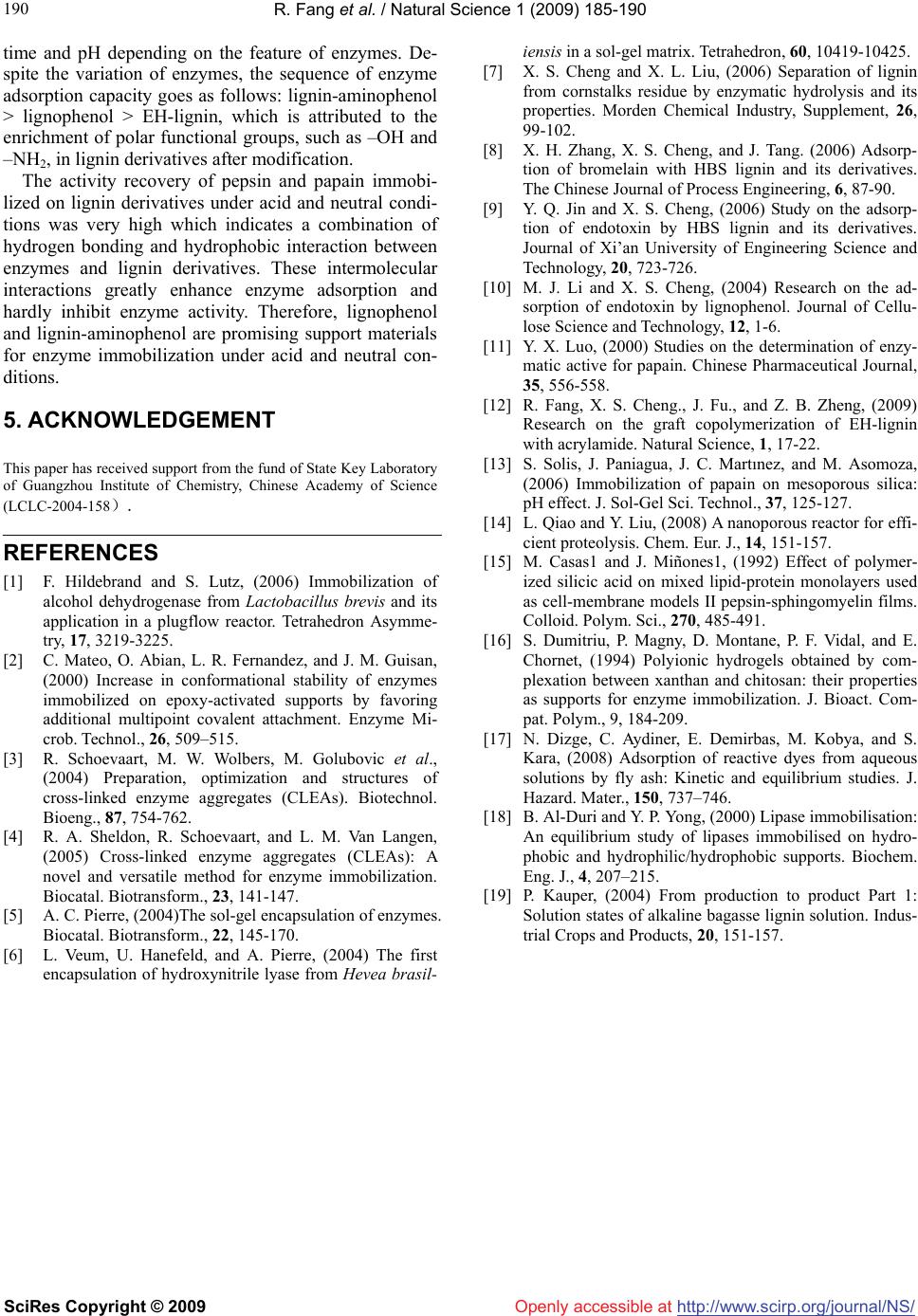
R. Fang et al. / Natural Science 1 (2009) 185-190
SciRes Copyright © 2009 http://www.scirp.org/journal/NS/
190
Openly accessible at
time and pH depending on the feature of enzymes. De-
spite the variation of enzymes, the sequence of enzyme
adsorption capacity goes as follows: lignin-aminophenol
> lignophenol > EH-lignin, which is attributed to the
enrichment of polar functional groups, such as –OH and
–NH2, in lignin derivatives after modification.
The activity recovery of pepsin and papain immobi-
lized on lignin derivatives under acid and neutral condi-
tions was very high which indicates a combination of
hydrogen bonding and hydrophobic interaction between
enzymes and lignin derivatives. These intermolecular
interactions greatly enhance enzyme adsorption and
hardly inhibit enzyme activity. Therefore, lignophenol
and lignin-aminophenol are promising support materials
for enzyme immobilization under acid and neutral con-
ditions.
5. ACKNOWLEDGEMENT
This paper has received support from the fund of State Key Laboratory
of Guangzhou Institute of Chemistry, Chinese Academy of Science
(LCLC-2004-158).
REFERENCES
[1] F. Hildebrand and S. Lutz, (2006) Immobilization of
alcohol dehydrogenase from Lactobacillus brevis and its
application in a plugflow reactor. Tetrahedron Asymme-
try, 17, 3219-3225.
[2] C. Mateo, O. Abian, L. R. Fernandez, and J. M. Guisan,
(2000) Increase in conformational stability of enzymes
immobilized on epoxy-activated supports by favoring
additional multipoint covalent attachment. Enzyme Mi-
crob. Technol., 26, 509–515.
[3] R. Schoevaart, M. W. Wolbers, M. Golubovic et al.,
(2004) Preparation, optimization and structures of
cross-linked enzyme aggregates (CLEAs). Biotechnol.
Bioeng., 87, 754-762.
[4] R. A. Sheldon, R. Schoevaart, and L. M. Van Langen,
(2005) Cross-linked enzyme aggregates (CLEAs): A
novel and versatile method for enzyme immobilization.
Biocatal. Biotransform., 23, 141-147.
[5] A. C. Pierre, (2004)The sol-gel encapsulation of enzymes.
Biocatal. Biotransform., 22, 145-170.
[6] L. Veum, U. Hanefeld, and A. Pierre, (2004) The first
encapsulation of hydroxynitrile lyase from Hevea brasil-
iensis in a sol-gel matrix. Tetrahedron, 60, 10419-10425.
[7] X. S. Cheng and X. L. Liu, (2006) Separation of lignin
from cornstalks residue by enzymatic hydrolysis and its
properties. Morden Chemical Industry, Supplement, 26,
99-102.
[8] X. H. Zhang, X. S. Cheng, and J. Tang. (2006) Adsorp-
tion of bromelain with HBS lignin and its derivatives.
The Chinese Journal of Process Engineering, 6, 87-90.
[9] Y. Q. Jin and X. S. Cheng, (2006) Study on the adsorp-
tion of endotoxin by HBS lignin and its derivatives.
Journal of Xi’an University of Engineering Science and
Technology, 20, 723-726.
[10] M. J. Li and X. S. Cheng, (2004) Research on the ad-
sorption of endotoxin by lignophenol. Journal of Cellu-
lose Science and Technology, 12, 1-6.
[11] Y. X. Luo, (2000) Studies on the determination of enzy-
matic active for papain. Chinese Pharmaceutical Journal,
35, 556-558.
[12] R. Fang, X. S. Cheng., J. Fu., and Z. B. Zheng, (2009)
Research on the graft copolymerization of EH-lignin
with acrylamide. Natural Science, 1, 17-22.
[13] S. Solis, J. Paniagua, J. C. Martınez, and M. Asomoza,
(2006) Immobilization of papain on mesoporous silica:
pH effect. J. Sol-Gel Sci. Technol., 37, 125-127.
[14] L. Qiao and Y. Liu, (2008) A nanoporous reactor for effi-
cient proteolysis. Chem. Eur. J., 14, 151-157.
[15] M. Casas1 and J. Miñones1, (1992) Effect of polymer-
ized silicic acid on mixed lipid-protein monolayers used
as cell-membrane models II pepsin-sphingomyelin films.
Colloid. Polym. Sci., 270, 485-491.
[16] S. Dumitriu, P. Magny, D. Montane, P. F. Vidal, and E.
Chornet, (1994) Polyionic hydrogels obtained by com-
plexation between xanthan and chitosan: their properties
as supports for enzyme immobilization. J. Bioact. Com-
pat. Polym., 9, 184-209.
[17] N. Dizge, C. Aydiner, E. Demirbas, M. Kobya, and S.
Kara, (2008) Adsorption of reactive dyes from aqueous
solutions by fly ash: Kinetic and equilibrium studies. J.
Hazard. Mater., 150, 737–746.
[18] B. Al-Duri and Y. P. Yong, (2000) Lipase immobilisation:
An equilibrium study of lipases immobilised on hydro-
phobic and hydrophilic/hydrophobic supports. Biochem.
Eng. J., 4, 207–215.
[19] P. Kauper, (2004) From production to product Part 1:
Solution states of alkaline bagasse lignin solution. Indus-
trial Crops and Products, 20, 151-157.